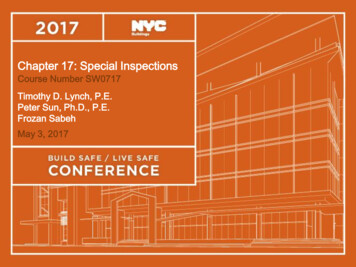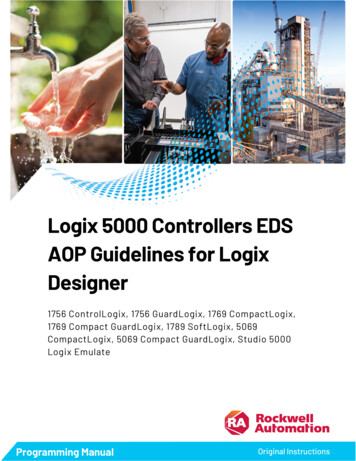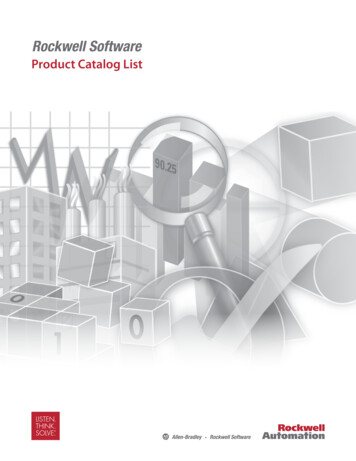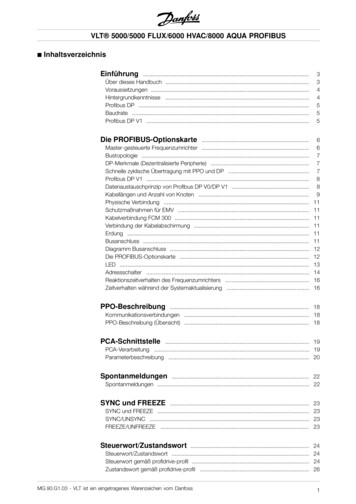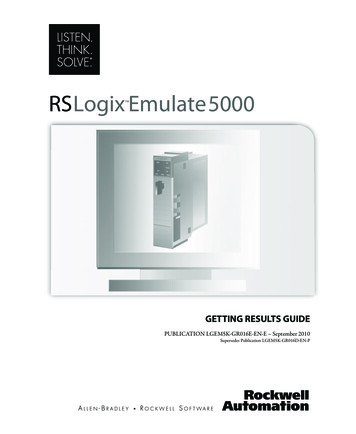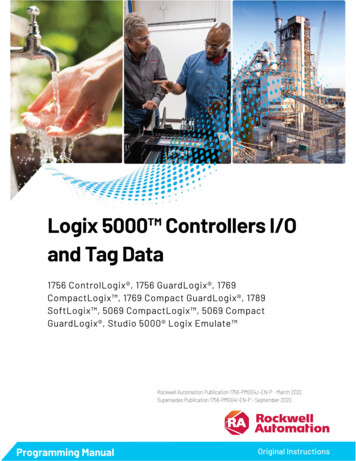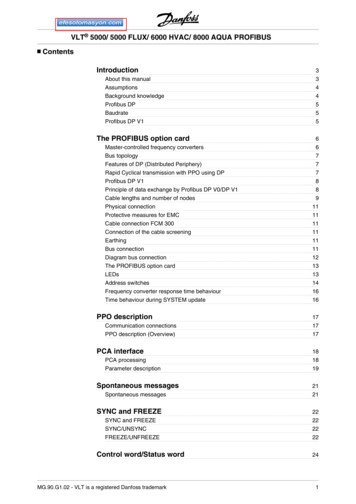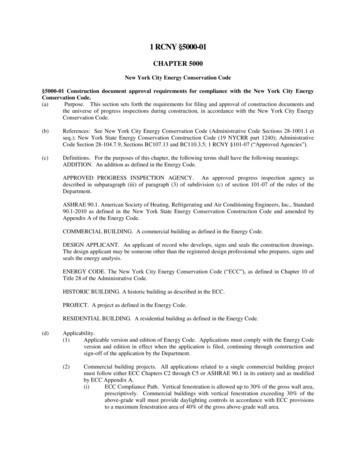
Transcription
1 RCNY §5000-01CHAPTER 5000New York City Energy Conservation Code§5000-01 Construction document approval requirements for compliance with the New York City EnergyConservation Code.(a)Purpose. This section sets forth the requirements for filing and approval of construction documents andthe universe of progress inspections during construction, in accordance with the New York City EnergyConservation Code.(b)References: See New York City Energy Conservation Code (Administrative Code Sections 28-1001.1 etseq.); New York State Energy Conservation Construction Code (19 NYCRR part 1240); AdministrativeCode Section 28-104.7.9, Sections BC107.13 and BC110.3.5; 1 RCNY §101-07 (“Approved Agencies”).(c)Definitions. For the purposes of this chapter, the following terms shall have the following meanings:ADDITION. An addition as defined in the Energy Code.APPROVED PROGRESS INSPECTION AGENCY. An approved progress inspection agency asdescribed in subparagraph (iii) of paragraph (3) of subdivision (c) of section 101-07 of the rules of theDepartment.ASHRAE 90.1. American Society of Heating, Refrigerating and Air Conditioning Engineers, Inc., Standard90.1-2010 as defined in the New York State Energy Conservation Construction Code and amended byAppendix A of the Energy Code.COMMERCIAL BUILDING. A commercial building as defined in the Energy Code.DESIGN APPLICANT. An applicant of record who develops, signs and seals the construction drawings.The design applicant may be someone other than the registered design professional who prepares, signs andseals the energy analysis.ENERGY CODE. The New York City Energy Conservation Code (“ECC”), as defined in Chapter 10 ofTitle 28 of the Administrative Code.HISTORIC BUILDING. A historic building as described in the ECC.PROJECT. A project as defined in the Energy Code.RESIDENTIAL BUILDING. A residential building as defined in the Energy Code.(d)Applicability.(1)Applicable version and edition of Energy Code. Applications must comply with the Energy Codeversion and edition in effect when the application is filed, continuing through construction andsign-off of the application by the Department.(2)Commercial building projects. All applications related to a single commercial building projectmust follow either ECC Chapters C2 through C5 or ASHRAE 90.1 in its entirety and as modifiedby ECC Appendix A.(i)ECC Compliance Path. Vertical fenestration is allowed up to 30% of the gross wall area,prescriptively. Commercial buildings with vertical fenestration exceeding 30% of theabove-grade wall must provide daylighting controls in accordance with ECC provisionsto a maximum fenestration area of 40% of the gross above-grade wall area.
(ii)(3)(e)Identification of related applications. Applicants must indicate in the application form allapplications related to the project or, if an application has not yet been filed, the name of theapplicant or the applicant’s firm and discipline for any anticipated related applications.Professional statement.Every application filed by a registered design professional for approval ofconstruction documents for a new building or alteration shall include a professional statement of eithercompliance with or exemption from the Energy Code.(1)Compliance. All new building and alteration applications must indicate compliance on theapplication form, except as specifically excluded in paragraph (2) of this subdivision.(2)(f)ASHRAE 90.1 Compliance Path. Vertical fenestration is allowed up to 40% of the grosswall area, prescriptively. If the vertical fenestration exceeds 40% of the gross wall area,the design team must use energy modeling in accordance with Section 11 of ASHRAE90.1 (“Energy Cost Budget Method”) or Appendix G of ASHRAE 90.1 (“PerformanceRating Method”) and as provided in subparagraph (iv) of paragraph (1) of subdivision (f)of this section or Section 5.6 of ASHRAE 90.1 (“Building Envelope Trade-off Option”).Exemption. Only applications that consist entirely of work exempt from the Energy Code mayindicate exemption in the professional statement. The application must state one of the followingbases for exemption:(i)Historic building.(ii)Envelope of low-energy building. All the proposed work is related to the envelopesystem of a low-energy or unconditioned building, as described in ECC Chapter 1.(iii)Categories of work not affecting energy use. Temporary structures (as described insections 28-111 and BC 3103) are exempt from compliance with the Energy Code. Inaddition, the following work types are exempt:(A)FA (fire alarm)(B)FP (fire suppression in a range hood)(C)SD (standpipe)(D)SP (sprinklers)(E)FS (fuel storage)(F)EQ (construction equipment)(G)CC (curb cut)(H)OT/BPP (builder’s pavement plan)(I)OT/FPP (fire protection plan).Energy analysis. An energy analysis is required for every project that is not entirely exempt. The energyanalysis shall identify the compliance path followed, demonstrate how the project design complies with theEnergy Code and, for commercial projects, indicate whether the project is designed in accordance withECC Chapters C2 through C5 or with ASHRAE 90.1.(1)Accepted formats for energy analysis. One of the following formats may be used to present theenergy analysis:(i)Tabular analysis. For new buildings, additions and/or alterations to existing residentialor commercial buildings for which either ECC Chapter 4, ECC Chapters C2 through C5or ASHRAE 90.1 has been used, the applicant may create a table entitled “EnergyAnalysis” as described in figure 1.
Such table shall compare the proposed values of each Energy Code regulated item in thescope of work with the respective prescriptive values required by the Energy Code. Theitems shall be organized by discipline, including Envelope Systems, Mechanical andService Water Heating Systems, and Lighting and Electrical Systems, as applicable.For commercial building additions and/or alterations involving lighting, the applicantmay choose to utilize the Lighting Application Worksheet from COMcheck for thelighting part of the analysis in lieu of including lighting in the tabular analysis; however,the supporting documentation index must provide a breakdown of each lighting fixture toclarify the location per room type or floor. See subparagraph (iii) of this paragraph andFigure 2 in subdivision (g) of this section.Figure 1: Sample tabular energy analysis:ENERGY ANALYSISCode chapter and/or standard used for designClimate Zone 4AItem DescriptionProposed Design Value(List all elements of the scope ofwork in the detail that they areaddressed by the energy code.)(ii)(List the value used in the design.)Code Prescriptive Value andCitation(List the prescriptive value requiredby the Energy Code and provide thecitation for such value.)REScheck Software Program. The REScheck software program available from theUnited States Department of Energy website may be used for residential buildings asfollows:(A) New buildings. REScheck may be used for new residential buildings.(B) Additions. REScheck may be used for additions only where a whole-buildinganalysis, including the existing building and the addition, is performed.(C) Alterations and repairs. REScheck may be used for alterations and repairs onlywhere a whole-building analysis, including the existing-to-remain and alteredenvelope and mechanical systems, is performed.(D) REScheck version.1.Only the New York State version of the REScheck form is permitted.(iii)2.For applications filed on or after December 28, 2010, the report mustspecify the 2010 Energy Conservation Construction Code of New YorkState.3.For applications filed before December 28, 2010, the report mustspecify the edition of REScheck that matches the edition of the EnergyConservation Construction Code of New York State in effect when theapplication was filed.COMcheck. The COMcheck software program available from the United StatesDepartment of Energy website may be used for commercial buildings as follows:(A)New buildings. COMcheck may be used for new commercial buildings.(B)Additions. COMcheck may be used for additions only as follows:1.Where a whole-building analysis, including the existing building andthe addition, is performed; or2.Where the COMcheck report states “addition” as the project type.
(C)Alterations and repairs. COMcheck may be used for alterations and repairs onlyas follows:1.Where a whole-building analysis, including the existing-to-remain andaltered parts of the building, is performed; or2.(D)(iv)Where the COMcheck report states “alteration” as the project type.COMcheck versions.1.Only the New York State versions of the COMcheck forms arepermitted.2.For applications filed on or after January 1, 2015, the report mustspecify the New York State Energy Code or New York State amendedASHRAE 90.1. In the event that a New York State-specific version isno longer supported, the report must specify the applicable IECC orASHRAE 90.1 version of the software.3.All three parts of the COMcheck report – the envelope, themechanical/service water heating and the lighting/power parts – shallbe presented, except where the project type is an addition or alterationas described above and some parts of the report are not relevant to thescope of work.Energy modeling based on DOE2. For new commercial buildings and additions oralterations to commercial buildings, where trade-offs among disciplines and/or theperformance path are used in accordance with ASHRAE 90.1 section 11 or Appendix G,an energy modeling program developed by the United States Department of Energy,including DOE2 or updates of DOE2, shall be used; such updates include DOE2.1E,VisualDOE, EnergyPlus and eQuest.Other energy modeling programs must be approved by the Secretary of State of NewYork State and the commissioner. The commissioner may at his or her discretion requirethe energy modeling report to be submitted to the Department.The applicant shall provide the project-relevant utility company energy cost time-of-userate structure in effect on January 1 of the calendar year in which the initial filing of theproject application(s) occurs, and shall utilize the time-of-use electricity, gas and steamprices from the rate structure in the energy model. Fuel oil prices used in the model shallbe supported by comparable local supplier information from the provider in effect onJanuary 1 of such calendar year.The results of the energy modeling report must be reported on a Department form.(v)Alternative formats. Formats other than those listed in subparagraphs i through iv of thisparagraph, including, but not limited to, the home energy software programs described insection ECC 101.5.1, may be used for a project only if they are approved in advance byboth the Secretary of State of New York State and the commissioner.(2)Mixed-occupancy buildings three stories or fewer. In accordance with section ECC 101.4.6,buildings three stories or fewer above grade with mixed residential and non-residentialoccupancies must comply with the respective requirements of Chapters 2 through 4 and ChaptersC2 through C5, and must have separate energy analyses, except that a tabular analysis format maybe used to show both the residential and non-residential requirements.(3)Build-outs of tenant space prior to issuance of new building certificate of occupancy. The energyanalysis for any alteration application for a build-out of a new building tenant space before the
final certificate of occupancy is issued must be consistent with the energy analysis for the newbuilding. Such energy analysis for the new building must be provided upon request.(4)Professional responsibility for energy analysis. The energy analysis shall be signed and sealed byregistered design professional(s).(i)Election. The project team must elect one of the following methods for performing theenergy analysis:(A)Responsibility by discipline. Where each system of the energy analysis –envelope, mechanical/service water heating and lighting/power – meets theprescriptive requirements of the Energy Code individually, different registereddesign professionals may sign and seal their respective parts of the energyanalysis report and include them as follows:1.If all such systems are filed with the Department under the sameapplication number, each registered design professional may includehis or her part of the energy analysis in his or her respective parts of theproject construction drawings.2.(B)If such systems are filed with the Department under differentapplication numbers, all parts of the energy analysis shall be filed in theinitial application for the project; except that in the case of foundationand earthwork permits issued pursuant to section 28-104.2.5, theenergy analysis for the new building project must be submitted withsubsequent construction documents. Refer also to paragraph (5) of thissubdivision.Lead professional. Where energy modeling (whole-building analysis) isperformed for the energy analysis or where the project design uses tradeoffsamong disciplines such that one or more systems of the energy analysis –envelope, mechanical/service water heating and lighting/power – could not meetthe prescriptive or performance requirements of the Energy Code on its own, alead professional must be identified who must sign and seal the entire energyanalysis for all systems involved.The energy modeling program must be based on the DOE2 energy modelingsoftware in accordance with subparagraph (iv) of paragraph (1) of thissubdivision. The energy analysis must be presented in the constructiondrawings for one application only. The lead professional must be a registereddesign professional and need not be a design applicant.(ii)(5)(g)Registered design professional other than a design applicant. A registered designprofessional other than a design applicant may prepare, sign and seal the energy analysis,either as lead professional or for individual discipline(s) in accordance with subparagraphi of this paragraph. Such registered design professional shall file a PW1 form as asubsequent filing and indicate “Energy” or “Electrical” as applicable in Section 6D, OT –Other.Foundation and earthwork permits. When phased or partial approval is requested by the applicantfor the purpose of issuance of a foundation and earthwork permit in accordance with §28-104.2.5of the Administrative Code, a tabular analysis must be filed showing the foundation insulationrequirements of the ECC. Refer also to subclause 2 of clause (A) of subparagraph (i) of paragraph(4) of this subdivision.Supporting documentation. The construction drawings submitted for approval shall provide all energydesign elements and shall match or exceed the energy efficiency of each value in each part of the energy
analysis – envelope, mechanical/service water heating and lighting/power. The supporting documentationshall be listed in a table that serves as an indexing guide to the construction document set. Such table shalllist the proposed values of each Energy Code-regulated item in the scope of work with the respectivelocation in the drawing set.Figure 2: Sample Supporting Documentation Index:SUPPORTING DOCUMENTATION INDEXCode chapter and/or standard used for designClimate Zone 4ACode SectionItem Description(List specific codesection)(List all elements of the scope of work in the detailthat they are addressed by the energy code.)Supporting DocumentationLocation(List the drawing page numberand/or section title.)In addition, other mandatory Energy Code requirements shall be provided as described in paragraphs 1through 5 of this subdivision.Further, supporting documentation shall provide all information necessary for a progress inspector to verifyduring construction that the building has been built in accordance with the approved constructiondocuments to meet the requirements of the Energy Code.For additions and alterations, the applicant must clearly show those physical portions of the systems thatare being brought up to code and those that are not being upgraded.(1)Envelope. Building wall sections and details shall be provided for each unique type ofroof/ceiling, wall, and either the foundation, slab-on-grade, basement or cellar assembly. Suchbuilding wall sections shall show each layer of the assembly, including, but not limited to,insulation, moisture control and air barriers. If continuous insulation is indicated, it must be fullycontinuous, uninterrupted by framing, slab edges, shelf angles, or any other continuous breaks inthe insulation. The insulation in each case shall be labeled and shall be equal to or greater than theR values, and an assembly in each case shall be equal to or less than the assembly U factors, in theenergy analysis.Door, window and skylight schedules shall include columns for U and SHGC values for eachfenestration assembly type, and such values shall be equal to or less than those in the energyanalysis. Mandatory requirements to prevent air leakage shall be detailed. Siding attachment overfoam sheathing shall comply with the Energy Code as required.(2)Mechanical/service water heating. Mechanical system design criteria, and mechanical and servicewater heating system and equipment types, sizes and efficiencies shall be provided.Space heating and cooling equipment, energy recovery equipment, economizers, ventilationequipment, service water heating equipment, and mandatory requirements including controlsystems, duct sealing and duct and piping insulation shall be shown on the construction drawingsand shall be equal to or greater than the energy efficiency requirements established in the energyanalysis, the Energy Code and/or this section, as applicable. A narrative shall be provided foreach mandatory control system describing its function and operation and specifying propersetpoints of equipment and controls.(3)Electrical. The applicant must provide supporting documents for lighting, power and controls oneither electrical drawings or drawings of other disciplines as appropriate. Such documents must: support the energy analysis; satisfy mandatory requirements of the Energy Code, such as controls, transformers,metering, voltage drop and electric motor requirements; and support progress inspections required by this section.
The drawings must be numbered with an “E,” “EN” or other discipline designator and must besigned and sealed by a registered design professional. If the registered design professional is anelectrical engineer, the engineer must file a PW1 form as an initial or subsequent filing andindicate either “Electrical” or “Energy” in Section 6D, OT – Other.(i)Interior and exterior lighting. Supporting documentation for lighting must be as follows:(A)Commercial buildings, except dwelling units. The applicant shall providereflected ceiling plans, floor plans and/or electrical drawings with lightinglayouts for each floor or space in the project, and for exterior lighting asapplicable.The lighting fixtures shall be described and keyed to the lighting plans, includingtype designation, brief description, locations, lamp type, ballast/transformer type,watts per lamp, quantity of lamps per fixture, and system input watts per fixture,such that the drawings support the energy analysis.In addition, mandatory lighting and power controls shall be shown and described,and a narrative provided describing their function and operation.Control devices and zones shall be indicated on drawings.(B)(ii)Dwelling units in residential and commercial buildings. In homes and dwellingunits, the applicant must indicate on floor plans what fixtures are to be installedwith high-efficacy lamps, and where the separate meter for each dwelling unit islocated.Exterior lighting zones. Exterior lighting zones as set forth in ECC Table C405.6.2(1)correspond with the following zoning districts in the New York City Zoning Resolution:Lighting zone 1:Lighting zone 2:Lighting zone 3:Lighting zone 4:(4)Park land.All R districts, R districts with C overlays and MX districts.M districts, except MX; C districts, except C5, C6 and Coverlays on R districts.C5 and C6 districts.(iii)Fan motors and controls. Fan motor horsepower and controls must be shown on thedrawings and described.(iv)Feeders. For applications using ASHRAE 90.1 for prescriptive compliance, calculatedfeeder voltage drops must be provided in accordance with ASHRAE 90.1.(v)Automatic receptacle controls. For applications using ASHRAE 90.1 for prescriptivecompliance, 50 percent of the receptacles must be automatically controlled and clearlyshown on the drawings in accordance with ASHRAE 90.1.Mandatory requirements. The construction documents shall comply with all mandatoryrequirements of the Energy Code.(i)For residential buildings, references for such requirements are listed in Section ECC401.2.(ii)For commercial buildings complying with the provisions of ECC Chapters C2 throughC5, references for such requirements are listed throughout Chapters C2 through C5; forcommercial buildings complying with ASHRAE 90.1, such requirements are set forththroughout the referenced standard.(iii)Commissioning statement. Every application filed by a registered design professional forapproval of construction documents for a new building or alteration under thecommercial provisions of ECC shall include a statement of either compliance with or
exemption from the commissioning requirements of the Energy Code as described inECC C408.(5)Permanent certificate in residential buildings. For residential buildings, the constructiondocuments shall indicate the following in accordance with Section ECC 401.3:(i)New buildings. For new buildings regulated under ECC Chapter 4, a permanentcertificate shall be required to be installed indoors and in accordance with Section ECC401.3, except that it may be posted near the electrical distribution panel at eye level andin plain sight.(ii)Additions and alterations. For additions and alterations affecting information on anexisting permanent certificate, such permanent certificate shall be updated, initialedwhere changed and reposted such that the values on the posted permanent certificateremain current.(6)Deferred submittals. Drawings showing design intent and performance criteria matching those inthe energy analysis may be submitted as supporting documentation provided that, in accordancewith Section 28-104.2.6 of the Administrative Code, the applicant lists such deferred submittals inthe construction drawings and submits them for approval prior to installation or construction. Ifrequired, the energy analysis must be updated when deferred submittals are provided for approval.(7)Required progress inspections. Supporting documentation shall also set forth all applicablerequired progress inspections in accordance with the Energy Code, 1 RCNY §101-07 and thissection.(i)Applicant’s instructions regarding required progress inspections. Progress inspectionsrequired to be performed during construction for any new building, addition or alterationproject shall be identified by the design applicant according to the scope of work andlisted and described in the approved construction drawings as required progressinspections.The description shall set forth the standard of construction and the inspection criteria asappropriate for the scope of work in accordance with Table I or Table II of subdivision(h) of this section, as applicable; simple reference to the citations provided, without suchdescription, is not sufficient.The applicant shall include the instruction that, in accordance with Section BC 110.9 andECC 104.2.3, where an inspection or test fails, the construction shall be corrected andmust be made available for reinspection and/or retesting by the progress inspector until itcomplies.For additions and alterations, the applicant must clearly indicate what portions of thealtered systems should be inspected and/or tested, and what inspection and/or testing maybe outside the scope of the work.(ii)Construction scheduling instructions. The drawings shall state that, in accordance withArticle 116 of Title 28 and Section BC 110, construction shall be scheduled to allowrequired progress inspections to take place, and that roofs, ceilings, exterior walls,interior walls, floors,foundations, basements and any other construction shall not becovered or enclosed until required progress inspections are completed or the progressinspector indicates that such covering orenclosure may proceed, at each stage ofconstruction, as applicable.(iii)Commercial building reference standards and citations. Progress inspection referencestandards and citations shall conform to the respective requirements of ECC Chapters C2through C5 or ASHRAE 90.1 as used for design, in accordance with the following:
(h)(A)When ECC Chapters C2 through C5 have been used for the project design, asreflected in the energy analysis, the applicant shall list on the drawings therespective references and citations for ECC for the progress inspection.(B)When ASHRAE 90.1 has been used for the project design, as reflected in theenergy analysis, the applicant shall list on the drawings the respective referencesand citations for ASHRAE 90.1 for the progress inspection.List of progress inspections required. The following progress inspections and/or testing set forth in TablesI and II shall be required when applicable to the scope of work and shall be identified/described in thesupporting documentation and included on the drawings submitted to the Department. Energy Codesections cited in Tables I and II of this section shall be understood to include the section, all subsections, alltables and, when ASHRAE 90.1 is used, appendices related to the cited Energy Code section.(1)Residential buildings. The progress inspections and tests described in Table I shall be performedfor buildings regulated by ECC Chapter 4. For heating, cooling and/or service hot water systemsin multiple dwellings, including where such systems serve a single dwelling unit, the applicantshall list inspections, tests and citations from Table II, in accordance with Section ECC 403.7.TABLE I – PROGRESS INSPECTIONS FOR ENERGY CODE COMPLIANCE – nce StandardECC or(minimum)(See ECC ChapterOther6) or Other CriteriaCitationIAEnvelope ion: Insulation shall be visuallyinspected to verify proper protection whereapplied to the exterior of basement or cellarwalls, crawl-space walls and/or the perimeterof slab-on-grade floors.Insulation placement and R-values:Installed insulation for each component of theconditioned space envelope and at junctionsbetween components shall be visuallyinspected to ensure that the R-values aremarked, that such R-values conform to the Rvalues identified in the constructiondocuments and that the insulation is properlyinstalled. Certifications for unmarkedinsulation shall be similarly visuallyinspected.Fenestration U-factor and product ratings:U-factors of installed fenestration shall beverified by visual inspection for conformancewith the U-factors identified in theconstruction drawings, either by verifying themanufacturer’s NFRC labels or, where notlabeled, using the ratings in ECC Tables303.1.3(1) and (2).Fenestration air leakage: Windows,skylights and sliding glass doors, except sitebuilt windows, skylights and doors, shall bevisually inspected to verify that installedassemblies are listed and labeled to theIA2IA3IA4Prior to backfillApprovedconstructiondocuments303.2.1As required toverifycontinuousenclosure whilewalls, ceilingsand floors 303.1.2,402.1,402.2,402.4.2.2,Table402.4.2As ings; NFRC 100303.1,303.1.3,402.1,402.3,402.6As requiredduringinstallationNFRC 400,AAMA/WDMA/CSA101/I.S.2/A440402.4.4
IA5IA6IA7referenced standard.Fenestration areas:Dimensions ofwindows, doors and skylights shall beverified by visual inspection.Air sealing and insulation – visualinspection: Openings and penetrations in thebuilding envelope, including site-builtfenestration and doors, shall be visuallyinspected to verify that they are properlysealed, in accordance with Table 402.4.2.Air sealing and insulation – testing: Testingshall be performed in accordance with sectionECC 402.4.2.1 and shall be accepted if thebuilding meets the requirements detailed insuch section. Test results shall be retained inaccordance with the provisions of Title 28.Prior to finalconstructioninspectionAs tiondocumentsApprovedconstructiondocuments; ASTME283; ASTM E84;RCNYS402.3Prior to finalconstructioninspectionASHRAE/ASTME779; ANSI constructiondocuments; ANSIZ21.60 (see also MC904), ANSI Z21.50Approvedconstructiondocuments303.1.5; BC2111; MCChapters 7,8, 9; FGCChapter 6403.5,403.7, C403ACCA Manual J;Approvedconstructiondocuments, includingenergy analysisApprovedconstructiondocuments, includingcontrol systemnarratives403.6,403.7,403.9, C403IBMechanical and Plumbing InspectionsIB1Fireplaces: Provision of combustion air andtight-fitting fireplace doors shall be verifiedby visual inspection.Prior to finalconstructioninspectionIB2Shutoff dampers: Not less than 20% ofinstalled automatic or gravity dampers, and aminimum of one of each type, shall bevisually inspected and physically tested forproper operation.HVAC and service water heatingequipment: Heating and cooling equipmentshall be verified by visual inspection forproper sizing. Pool heaters and covers shallbe verified by visual inspection.HVAC and service water heating systemcontrols: System controls shall be inspectedto verify that each dwelling is provided withat least one individual programmablethermostat with capabilities as described inECC 403.1.1, and that such controls are setand operate as specified in ECC 403.1.1.Prior to finalconstructioninspectionIB3IB4Controls for supplementary electric-resistance
DESIGN APPLICANT. An applicant of record who develops, signs and seals the construction drawings. The design applicant may be someone other than the registered design professional who prepares, signs and seals the energy analysis. ENERGY CODE. The New York City Energy Conservation Code ("ECC"), as defined in Chapter 10 of
